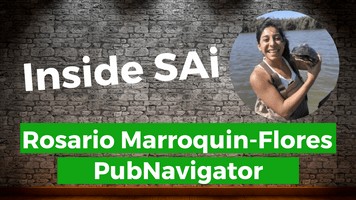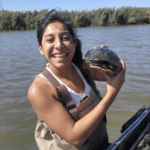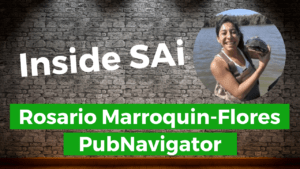- October 4, 2021
- Posted by: Ariana
- Category: Resident Stories

The SAi community is filled with Residents, Fellows, and staff who strive to make a difference within various STEM communities.

Each SAi member comes into our incubator with a problem they or others face and an idea on how they would like to solve it. They then work to build programs and projects that create an impact greater than ever thought imaginable. Over the next few months, we will highlight the work of each of our SAi residents for others to gain insights as well as connect to the interdisciplinary worlds of STEM engagement, outreach, communication, and education.
In this edition of Inside SAi, we caught up with SAi Junior Resident Rosario Marroquin-Flores (RMF), the Founder and Senior Editor of PubNavigator, to chat about how this platform came to be and how SAi is helping advance its mission to improve science literacy by making scientific research accessible.
SAi: In your own words, what is PubNavigator? How does it make a difference?
RMF: PubNavigator is a science communication platform that shares the findings of published papers using accessible language. Scientists generally share their research findings by publishing peer-reviewed papers in academic journals, but the findings conveyed in these papers rarely reach the public. They are rarely covered in the news and many exist behind a paywall. These papers also contain complex language and are difficult to read. Ultimately, published papers are not accessible to general audiences. Our mission is to improve science literacy by making scientific research more accessible to general audiences.
SAi: How did this idea come to mind?
RMF: Academia is very insular. As a Ph.D. student, it became clear that the information I had access to was very different from the information that people in my family had access to. Science is a big part of my life, and I wanted to share that with the people I am closest to. In a way, scientists speak their own language. We have specialized knowledge and use specialized language to communicate and to collaborate. My goal with this project was to bring other people into the fold. I want everyone to have access to the same information that scientists have access to.
SAi: What was the process like creating this platform?
RMF: PubNavigator originally started as a small-scale project highlighting student publications at my home institution. I am the president of our local Society Advancing Chicanos/Hispanics and Native Americans in Science (SACNAS) chapter. We produce an annual print publication with a format similar to PubNavigator articles. The problem with the original project is that it is limited in its reach and its scope. The process of transitioning this onto an online platform took more planning. I had to figure out a submission process, recruit and train volunteers, establish benchmarks for success and a means of evaluation, and ultimately design the platform.
SAi: How does PubNavigator stand out from other platforms? What makes it unique?
RMF: PubNavgiator is unique in several ways. There are several science communication outlets, but most of them work to craft a narrative. They might come in the form of a popular science article, like something you might read in a magazine, or they might share a story about a scientist’s journey or a large research project. PubNavigator is unique in that the articles share the findings of the primary research directly. The primary author will write the article on the publication or will oversee the writing process. Peer-reviewed publications are how scientists share our most recent research advances, and PubNavigator gives readers access to the same information.
Additionally, every paragraph in a PubNavigator article is written at or below a 12th-grade reading level. We provide definitions for complex terms and links to additional information (articles, videos, etc.) that can help contextualize the research. Finally, we include biographical information about the author and information about the research team so that readers can meet the scientist behind the study. The biographical information helps to make scientists more relatable. We’re regular people too!
SAi: How has SAi helped you during this process?
RMF: SAi was critical to the development of PubNavigator. When I started as a Cohort 4 Fellow, I was just hoping to develop a better rubric and get feedback on how to improve my project. SAi helped me cultivate my project, identify a problem-solution fit, build a mission statement, evaluate my project, and expand it. I was paired with a mentor that helped me design a logo, select a platform, and build the website. SAi has continued to help by promoting my platform and providing seed funding. Essentially, SAi provided all the resources I needed to leave my comfort zone and build a project that I care about.
SAi: What advice do you have for others looking to break into the field?
RMF: Don’t be afraid to push yourself outside your comfort zone. I am not particularly computer-savvy, and building the PubNavigator platform was an uphill battle. Still, I’m happy that I pushed myself to do something that I had no experience in. There are several resources and people in the community that can help you!
SAi: If others have more questions, where can they find/contact you?
RMF: If you’re interested in learning more about my project or just chatting, I can be contacted through my Twitter account (@rmarroqu3) or via a message on PubNavigator through the contact page.

